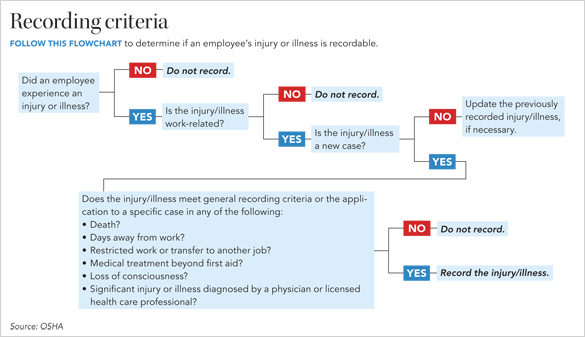For the record
Breaking down OSHA’s recordkeeping requirements

KEY POINTS
- Many industries and small businesses are not required to record injuries and illnesses.
- Employers required to keep and maintain records must fill out three OSHA forms: 300, 300A and 301.
- In certain cases, employers must maintain the privacy of the injured or ill worker's identity when filling out OSHA forms.
Keeping workers safe on the job cannot be accomplished solely through appropriate training and inspections – accurate recordkeeping also plays a role. Knowing how many, where and what type of injuries have occurred can help employers create a safer work environment.
"It’s great for employers who are required to maintain an accurate record of their experiences," said Jim Stanley, former OSHA assistant administrator and current president of FDRsafety, a Franklin, TN-based consulting firm. "It’s an indicator of where they’ve been and where they’re going to go if they don’t do something about it."
As Stanley alluded to, many companies are required by law to keep and maintain workplace injury and illness records. OSHA’s Recording and Reporting Occupational Injuries and Illnesses Standard (1904) outlines those requirements, including what injuries or illnesses should be recorded.
However, following the standard is not as easy as it may seem. "It’s very hard to maintain OSHA records accurately, and that’s due in part because the standard has so many nuances and it’s difficult to understand," said Bill Taylor, a recordkeeping expert and principal safety scientist at Marshville, NC-based consulting firm EI Group.
Taylor said people’s misunderstanding of the standard’s requirements can lead to underreporting of injuries. Such underreporting may paint an inaccurate picture of safety, which can result in OSHA citations.
Safety+Health presents a brief overview of the requirements of the recordkeeping standard, common mistakes employers make, and other useful tips to remember when attempting to maintain accurate OSHA-required records.
Am I exempt?
Most employers are not required by law to keep injury and illness records. Exemptions from recordkeeping include:
- Ten or fewer people employed during the year. Employers must add up the total number of employees during the year – including full-time, part-time and seasonal employees. If that number totals more than 10 at any point during the year, the employer must keep injury and illness records.
- Certain industries, including hardware stores; funeral service and crematories; new and used car dealers;child day care services; liquor stores; and radio, television and computer stores, among many others.

However, exempted employers must keep records if asked to do so by OSHA or the Bureau of Labor Statistics.
Determining work-relatednessA major hurdle employers face in determining whether an injury or illness should be recorded is ascertaining whether the injury occurred on the job. A general rule of thumb, according to Taylor, is that if the injury or illness occurred in the work environment, it is recordable.
That tip comes with several big asterisks, however. Exceptions exist when the injury or illness did not receive any medical treatment beyond first aid, even if the employee was taken to a hospital.
“The hospital is irrelevant. You could go to a hospital and receive first aid treatment,” Taylor said, meaning the injury would not be required to be recorded.
The medical treatment aspect also has exceptions. For example, if an employee is injured, falls down and loses consciousness, and then wakes up and requires no additional medical treatment, it is still recordable because it meets the recording requirements (loss of consciousness – see “Recording criteria” flowchart, below).
Another example is the death of an employee in a commercial airline crash when traveling for work. Even though it did not occur at the worksite, the death is recordable (but OSHA would not require it to be reported in this particular situation).
Employers also should be aware that an injury can be recordable but not deemed compensable in the workers’ compensation system. The two are completely separate issues, Taylor warned.
Post a comment to this article
Safety+Health welcomes comments that promote respectful dialogue. Please stay on topic. Comments that contain personal attacks, profanity or abusive language – or those aggressively promoting products or services – will be removed. We reserve the right to determine which comments violate our comment policy. (Anonymous comments are welcome; merely skip the “name” field in the comment box. An email address is required but will not be included with your comment.)

